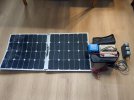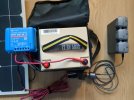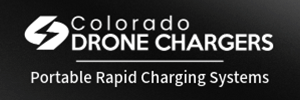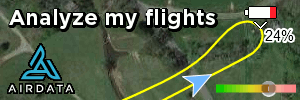I wasn't happy with the "portable" power brick options available for field charging our batteries. They were either too expensive, too inefficient, or too unreliable. I didn't need an AC inverter, since everything I use in the field is DC. Those small inverters only give you 80% conversion efficiencies anyway and would just be more weight.
So I did what all DIYers should do and built my own. Using the skills I learned building my home solar power system I looked for the best possible components that would give me light weight, portability, and scalability. Studying the problem, I found there was a lot of confusion around the USB C power protocols and how those power levels are delivered to devices, so you need a system capable of delivering 20 A to the charger. If you're not getting full wattage to your batteries that is likely your bottleneck.
Here's my build:
(Costs in $USD)
Zeee Lipo Fireproof Safe Bag (Amazon) $21
Anker USB-C Car Charger, 167.5W Max 3-Port Ultra-Compact Type-C Fast Car Charger (Amazon) $36
Victron Energy SmartSolar MPPT Solar Charge Controller (48V) 100 - 20 (Amazon) $88
Power Queen 12.8V 50Ah LiFePO4 20A output BMS (Amazon) $126
2 x 50 Watt monocrystalline flexible 12 V solar panels in series (Already had these)
Anker USB C - C 100 W 6ft cable (Amazon) $9
Test results and notes:
This shoud give me 3-4 full charge cycles for my 3 x Air 3 batteries (12723 mAh total). The Victron controller supports any solar panels up to 100 V @ 20 A with real MPPT to get the most out of your PV. It also has an excellent Bluetooth app for full system monitoring. This lets me use much more efficient house-type 48V framed panels if I want. The controller will support a 20 A load output. The thin flexible panels I have aren't great and only give about 65W at best, but that is enough to keep the battery charging a bit. I can connect two other USB devices to the charger at the same time, a phone and RC2 controller for instance.
The Anker charger does a great job negotiating the load and doesn't overheat. I measured the USB C output to be 20 V and 5 Amps while bulk charging the batteries, so 100 W. I think the next step will be to get the Renogy 200W ($200) portable solar panels, which seem to give about 180W from user reviews.
The total cost of the system was $280 and it weighs around 15 lbs (7 kg) and can be carried in a backpack or on my shoulder. The panels can be disconnected for portability or left off if I am walking or riding offroad.
What solutions have you all found for field charging?
So I did what all DIYers should do and built my own. Using the skills I learned building my home solar power system I looked for the best possible components that would give me light weight, portability, and scalability. Studying the problem, I found there was a lot of confusion around the USB C power protocols and how those power levels are delivered to devices, so you need a system capable of delivering 20 A to the charger. If you're not getting full wattage to your batteries that is likely your bottleneck.
Here's my build:
(Costs in $USD)
Zeee Lipo Fireproof Safe Bag (Amazon) $21
Anker USB-C Car Charger, 167.5W Max 3-Port Ultra-Compact Type-C Fast Car Charger (Amazon) $36
Victron Energy SmartSolar MPPT Solar Charge Controller (48V) 100 - 20 (Amazon) $88
Power Queen 12.8V 50Ah LiFePO4 20A output BMS (Amazon) $126
2 x 50 Watt monocrystalline flexible 12 V solar panels in series (Already had these)
Anker USB C - C 100 W 6ft cable (Amazon) $9
Test results and notes:
This shoud give me 3-4 full charge cycles for my 3 x Air 3 batteries (12723 mAh total). The Victron controller supports any solar panels up to 100 V @ 20 A with real MPPT to get the most out of your PV. It also has an excellent Bluetooth app for full system monitoring. This lets me use much more efficient house-type 48V framed panels if I want. The controller will support a 20 A load output. The thin flexible panels I have aren't great and only give about 65W at best, but that is enough to keep the battery charging a bit. I can connect two other USB devices to the charger at the same time, a phone and RC2 controller for instance.
The Anker charger does a great job negotiating the load and doesn't overheat. I measured the USB C output to be 20 V and 5 Amps while bulk charging the batteries, so 100 W. I think the next step will be to get the Renogy 200W ($200) portable solar panels, which seem to give about 180W from user reviews.
The total cost of the system was $280 and it weighs around 15 lbs (7 kg) and can be carried in a backpack or on my shoulder. The panels can be disconnected for portability or left off if I am walking or riding offroad.
What solutions have you all found for field charging?
Attachments
Last edited:











